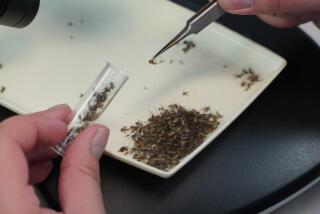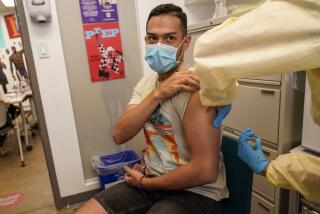AIDS Cases Edge Up 5% as Other Sexually Transmitted Diseases Drop
- Share via
SANTA ANA — Sexually transmitted diseases decreased dramatically last year in Orange County, a trend that health officials attributed to increased awareness about AIDS.
Though reported cases of AIDS rose slightly in 1995 from 538 to 566, officials said the 5% jump was statistically insignificant.
“AIDS reports are a snapshot of what was happening in terms of disease transmission 10 years ago,” said Penny Weismuller, disease control manager for the Orange County Health Care Agency, which issued its 1995 disease tally Friday.
More important than the rise in the number of AIDS cases, Weismuller said, was the sharp countywide drop in reported cases of gonorrhea, chlamydia and syphilis--diseases that have a far shorter incubation period than AIDS.
Apparently, Weismuller said, efforts to educate the public about AIDS are helping slow the spread of other sexually transmitted diseases.
“Hopefully, it’s because people are listening to the prevention message we’ve been giving for many many years that’s related to the HIV epidemic,” Weismuller said.
Syphilis showed the most dramatic falloff in the year ending December 1995, dropping roughly 50%, from 318 cases to 153.
Chlamydia fell 28%, from 4,563 cases to 3,303 cases, after rising 9% the previous year.
Gonorrhea fell 15%, from 510 cases in 1994 to 433 in 1995.
Weismuller said the public must guard against overconfidence regarding the downward trend in sexually transmitted diseases.
“You can’t say, ‘I don’t need to worry. STD’s are down,’ ” she said. “The reason they’re down is people are taking the preventive message seriously.”
Along with sexually transmitted diseases, cases of tuberculosis continued to decline in Orange County.
After reaching a high of 431 cases in 1993, when the disease struck more than 100 students at La Quinta High School in Westminster, tuberculosis dipped by 9% in 1995. Last year’s 336 cases represents a trend toward the tuberculosis levels seen at the start of the decade.
Weismuller said the reason may be a more aggressive approach taken by physicians, who now recognize and report the disease earlier.
More to Read
Sign up for Essential California
The most important California stories and recommendations in your inbox every morning.
You may occasionally receive promotional content from the Los Angeles Times.










